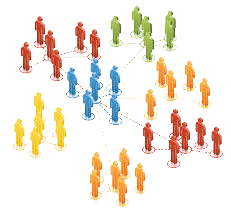Day 1 (February 29th)
Readings:
Before class, our fellow students will read the following
- http://www.orgnet.com/sna.html
- http://www.facegroup.com/blog/detecting-communities-using-social-network-analysis/
The readings provide a very good starting point for what we would like to include in our presentation on Social Network Analysis on the first day. It provides topics for us to use as discussion questions in class and provides a general understanding of the topic before we talk about it in class.
In Class:
- Watch two short videos explaining briefly what Social Network Analysis is and how it affects our lives.
- https://www.youtube.com/watch?v=Qj2uWpYsdcM
- https://www.ted.com/talks/nicholas_christakis_the_hidden_influence_of_social_networks/transcript?language=en (11:46 – 13:18)
- Discussion Time
- After seeing the videos, what is your first reaction to the concept of social network analysis?
- How does social media facilitate your connections?
- What communities are you most connected to?
- Have the class think about how many social media platforms they are apart of and come up with a number.
- Explain Social Network Mapping and how it relates to Big Data.
- Discussion in same groups of 3-4
- What is important to these groups?
- Who shares the targeted information?
- How can they be targeted based on the dynamic existing within the group?
- What kind of information could be spread using these social groups?
- We looked at different examples of maps and explained them and the amount of influence one individual had over a larger group of people.
- Activity
- In groups of three or four we would like you to look at the maps provided and try and decide which person would be the best individual to use in the social network map to get the information spread the most quickly. Why do you think this individual would be the best option?
Everything we had took until the end of class, because we had specifically planned how long we wanted to take with everything.
Homework:
To be completed before class on Wednesday March 2, 2016:
In a 400-500 word blog post, we want you to think about how information gets shared through your social media.
- Think about your networks and sub-networks on social media. Are your groups connected or kept mostly separated? How do you think this affects the variety of posts in your feed?
- Think about whose posts appear most often on your feed, and the sorts of posts you like, comment, share, retweet and so on. What sort of posts are you most drawn to and what is your connection to the people who post them? How do you think you are influenced by your friends on social media?
- Now think about the things that you post. Who are the people who usually react to your posts, what is your connection with them? How do you think you influence others through social media?
- You should have a better understanding of how influence works through your social networks now. How do you feel about sites like Facebook having access to this information? Looking at the readings, how do you think they can use this information to manipulate your social networks? How do you feel about this?
Day 2 (March 2)
Readings:
- http://www.theatlantic.com/technology/archive/2014/04/behind-the-machines-back-how-social-media-users-avoid-getting-turned-into-big-data/360416/
- http://www.zdnet.com/pictures/ten-examples-of-extracting-value-from-social-media-using-big-data/
- http://www.slate.com/articles/health_and_science/science/2014/06/facebook_unethical_experiment
In Class:
- Show two short videos depicting the real life applications of Social Network Analysis
- https://www.youtube.com/watch?v=_e63moYZYG8
- https://www.youtube.com/watch?v=5CFxyRqy6mI
- Discussion:
- Get into groups and brainstorm some possible real-life applications of Social Network Analysis.
- Discuss the article from Slate.com about Facebook’s unethical Practices
- Discussion in groups
- After viewing these examples of real-life applications of social network analysis, what do you think are the pros and cons of using it for these purposes?
- We talked about ways people try and avoid the algorithms conducting Social Network Analysis and explained three different ways by showing examples and a video
- https://www.youtube.com/watch?v=GBt2QrkBONQ
- Discussion
- Do you think you participate in subtweeting, screenshotting, or hatelinking?
- If so, why? Why do you think it is so effective?
- Briefly talk about Recontextualisation and Social Privacy
- Discussion
- Hypothetically, do you imagine in the future that there will be algorithms to track this type of behavior and include it in the analysis?
- What do you feel the pros and cons of this will be?
After the final discussion question, we finished our lesson.
Roles:
We each took time and discussed what we felt was important to different parts of lecture. None of us really had specific roles per say, because we almost always came back and discussed any changes we had made or were going to make with the group. We each brought different readings we felt were important and discussed them. We wrote blogs together and separately. Ultimately Margaret’s blog was the one we decided on using for the post. I made sure to get the reading posted once we decided what to do. We each added things individually to the PowerPoint and those were the things we individually talked about in class. With the exception of that Monday class, because I had spent the night before in the Emergency Department. We may have done things individually, but everything was discussed and decided on as a group. I, however, went through all of the blogs and decided whether or not the blogs were satisfactory or unsatisfactory.
